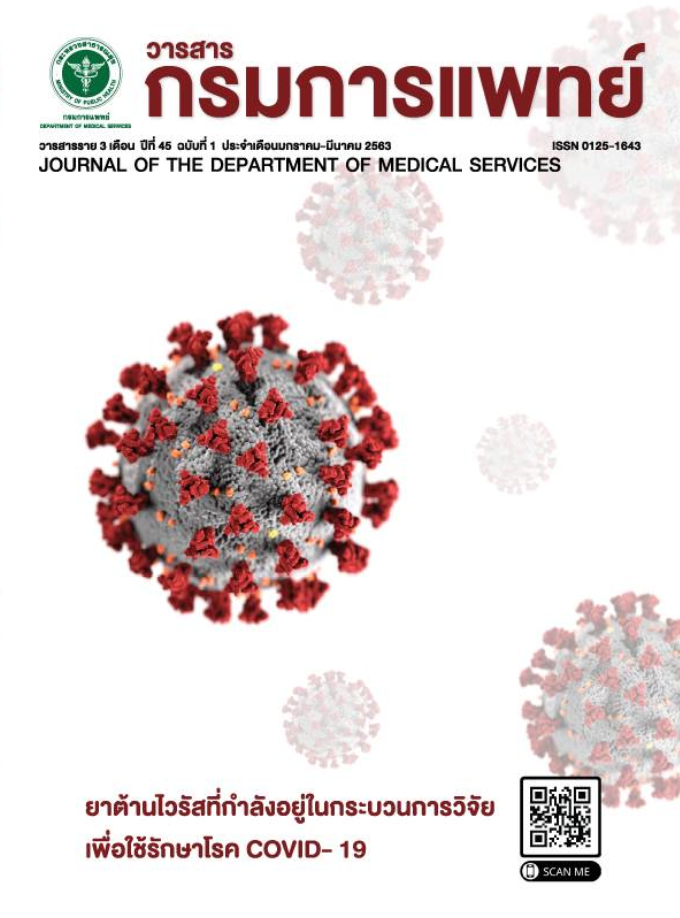The Measurement of Entrance Surface Air Kerma for Digital Radiography Using OSL NanoDot™ Dosimeter
Keywords:
Entrance skin air kerma (ESAK), NanodotTM, Digital radiographyAbstract
The assessment of entrance skin air kerma (ESAK) from radiographic examination can be performed either the calculation method recommended by International Atomic Energy Agency report no. 457, or the direct measurement using a dosimeter. The aims of this study were to measure the values of ESAK using NanodotTM dosimeter and compare those with the calculation method and to measure doses for eye lens, thyroid gland and breast received from the examination. The six of most common radiographic examinations were performed using an adult female phantom. The routine exposure parameters used for the hospital were set. The results revealed that the values of ESAK for skull anteroposterior (AP) and lateral cross table, the chest posteroanterior (PA), Aabdomen supine (AP) and upright (AP) and the pelvis AP were 1.51, 1.51, 0.16, 7.69, 1.33 and 8.03 milligray (mGy), respectively. The percentage differences between both methods were within ±16.88% the maximum doses for the eye lens, breast and thyroid gland received from the examinations were 1.52, 1.78 and 0.87 mGy, respectively. The values of ESAK from the measurement using NanodotTM were lower than those from the calculation method. This was because the axis of nanodotsTM was not perpendicular to the x-ray beam. The measured and calculated ESAKs for the skull and chest radiographs obtained in this study were lower than the dose level recommended by the department of medical sciences, Thailand but those for the abdomen and pelvis were higher. The exposure techniques can be further reviewed by the hospital authority in order to reduce doses for patients
References
Yensri L. Comparison of radiation absorbed doses among patients undergoing standard chest radiographic examination by computed radiography (CR) and digital radiography (DR). The Southern College Network Journal of Nursing and Public Health 2016; 1: 129-39.
Charoenwikrom C. Technology assessment between digital radiography and computed radiography. Bulletin of the department of medical sciences 2014; 39: 184-8.
Kamiya K, Ozasa K, Akiba S, Niwa O, Kodama K, Takamura N, et al. Long-term effects of radiation exposure on health. Lancet 2015; 386: 469-78.
International Atomic Energy Agency (IAEA). Dosimetry in Diagnostic Radiology: An International Code of Practice In: Technical Reports Series no. 457 (TRS 457).Vienna; 2017.
Perks CA, Yahnke C, Million M. Medical dosimetry using Optically Stimulated Luminescence dots and microStar readers. International Atomic Energy Agency (IAEA) 2008: 1-10.
Takegami K, Hayashi H, Nakagawa K, Okino H, Okazaki T, Kobayashi I, et al. Measurement method of an exposed dose using the nanoDot dosimeter. ESR 2015: 1-16.
Tongruang C, Sirichai Theirrattanakul S, Diswath W. Characterization of an optically stimulated luminescence NanoDot dosimeters for diagnostic radiology. Bulletin of the department of medical sciences 2016; 58:141-8.
Al-Senan RM, Hatab MR. Characteristics of an OSLD in the diagnostic energy range. Med Phys 2011; 38: 4396-405.
Fung KK, Gilboy WB. Anode heel effect on patient dose in lumbar spine radiography. Br J Radiol 2000; 73: 531-6.
Okazaki T, Hayashi H, Takegami K, Okino H, Kimoto N, Kobayashi I, et al. Fundamental Study of nanoDot OSL Dosimeters for Entrance Skin Dose Measurement in Diagnostic X-ray Examinations. JRPR 2016; 41: 229-36.
Stewart FA, Akleyev AV, Hauer-Jensen M, Hendry JH, Kleiman NJ, MacVittie TJ, et al. ICRP Publication 118: ICRP statement on tissue reactions and early and late effects of radiation in normal tissues and organs — threshold doses for tissue reactions in a radiation protection context. Ann ICRP 2012; 41: 1–322.
Mohammed AA, Ahmed A. Estimation of Radiation Dose for Adult Patients Undergoing Diagnostic X-ray Examinations of the Skull and Cervical Spine. IOSR-JAP 2017; 9: 33-6.
Buncharat S, Hamuttiti P. Patient doses in simple radiographic examinations in Trang, Phatthalung and Satun provinces in the transition from x-ray film to computed radiography. Journal of Health Science 2016; 25:632-40.
Downloads
Published
How to Cite
Issue
Section
License
บทความที่ได้รับการตีพิมพ์เป็นลิขสิทธิ์ของกรมการแพทย์ กระทรวงสาธารณสุข
ข้อความและข้อคิดเห็นต่างๆ เป็นของผู้เขียนบทความ ไม่ใช่ความเห็นของกองบรรณาธิการหรือของวารสารกรมการแพทย์



